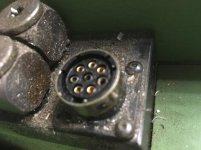ballen
Diamond
- Joined
- Sep 25, 2011
- Location
- Garbsen, Germany
I'm thinking about buying a used HENSOLDT WETZLAR centering scope, meant for a Deckel mill. These come in at least three types:
- early, gray hammertone paint, one bulb, no swivel joint
- later, gray hammertone paint, 4 bulbs, swivel joint
- latest, red paint, 4 bulbs, swivel joint
It would help me to decide which type to get and to evaluate it, if I could read the instructions. I know that several people here have one of these centering microscopes. Please, could one of you scan and post the instruction manual? English, German or French would all be OK.
Cheers,
Bruce
- early, gray hammertone paint, one bulb, no swivel joint
- later, gray hammertone paint, 4 bulbs, swivel joint
- latest, red paint, 4 bulbs, swivel joint
It would help me to decide which type to get and to evaluate it, if I could read the instructions. I know that several people here have one of these centering microscopes. Please, could one of you scan and post the instruction manual? English, German or French would all be OK.
Cheers,
Bruce









 ... did you ever get a set of instructions??
... did you ever get a set of instructions??


